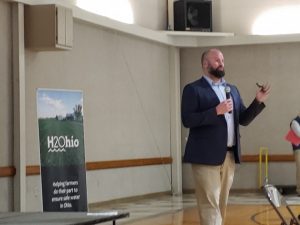A Million Dollar Response – H2Ohio Meetings
By Dusty Sonnenberg, CCA, Ohio Field Leader
Last week, three H2Ohio informational meetings were conducted by representatives from the Ohio Department of Agriculture (ODA), Ohio Agricultural Conservation Initiative (OACI) and local county soil and water conservation district offices. Over 1,000 farmers and agribusiness people have attended so far according to organizers. The meetings were held in Perrysburg, Delphos, and Defiance, with every venue at capacity.
“This is a tremendous outpouring of farmers and the farming community who believe with all their hearts in the power of voluntary conservation efforts. It is a shame the general public cannot see everyone here tonight, this is tremendous,” said Dorothy Pelanda, Director of the Ohio Department of Agriculture, addressing members of the agriculture community in attendance at the Defiance meeting last Wednesday evening.
Earlier in January, Ohio Governor Mike DeWine and ODA Director Pelanda announced that $30 million in H2Ohio funding would be available to Ohio farmers in a 14-county area of the Maumee River Watershed to implement select conservation practices.
During the informational meetings, Clark Hutson, Chairman and Commissioner of H2Ohio in the Maumee Basin, gave an overview of the program and goals. Hutson explained that enrollment began on Feb. 1, and will continue until March 31.
“Farmers can stop in their local county soil and water conservation office to begin the process,” Hutson said.
After the March 31 date, the program will not be closed, however enrollment will be paused until the soil and water offices can process the enrollments to that point and determine where the H2Ohio program is at in terms of total enrollment and funding. Once determined, more money can be requested from the state if necessary, and dates to resume the enrollment will be determined.
Terry Mescher, Conservation Engineer and Commissioner of H2Ohio at the ODA, explained specific details about each of the seven practice farmers can implement. Mescher highlighted the “stacking” of practices on acres where it fit, as all but two sets of practices could feasibly be done in conjunction with one another. Another point of emphasis by Mescher focused on the importance of the Voluntary Nutrient Management Plan (VNMP).
“The delivery of the H2Ohio program overall is going to be based on the Voluntary Nutrient Management Plan, or VNMP. The VNMP is the cornerstone and foundation on which the rest of the practices will be set,” Mescher said. “All the practices will require a VNMP first.”
Scott Higgins, CEO of the Ohio Dairy Producers, and Heather Taylor-Miesle, Executive Director of the Ohio

Environmental Council explained what the Ohio Agricultural Conservation Initiative (OACI) is and who is involved in the initiative. The OACI is made-up of a number of agricultural and environmental organizations aimed at working together to advance a voluntary program to improve water quality and work toward continuous improvement.
“After reaching out to the farming community, the Ohio Environmental Council realized three things. We learned that farmers are the original stewards of the land, that farmers care a great deal about water, and that by working together we can do this,” Taylor-Miesle said.
Over the past two years, the agriculture community has been working with the environmental community to identify common goals and a path to achieve them.
“To achieve the goals of the OACI, it was quickly determined that a voluntary program that is customizable is going to be a key,” Higgins shared. “One size fits all doesn’t work. We believe that if we put together a progressive voluntary program that could identify the best management practices, which if implemented widely and broadly, we could move the needle in improving water quality.”

Jordan Hoewischer, Ohio Farm Bureau’s Director of Water Quality and Research explained what the OACI is designed to do, and how it connects to H2Ohio.
“These are really two different programs with one mission,” Hoewischer said referring to both H2Ohio and OACI. “Tax dollars are funding the BMPs through the ODA. OACI is funded by the agricultural organizations and commodity groups and environmental organizations that make up the OACI. Both programs are administered by the Ohio Federation of Soil and Water Conservation Districts to get these programs put together.”
OACI is ultimately a farmer certification program.
“It is going to be a requirement to be a part of the OACI system to get your first year of funding,” Hoewischer said. “A farmer profile will need to be completed prior to receiving funds for the H2Ohio practices.”
Assistance will be provided by local soil and water offices and the commodity organizations to get farmers certified by OACI. The certification is designed to quantify what is currently being done on Ohio’s farmland, and also to provide assurance and documentation that farmers enrolled are doing the right things moving forward.
Additional H2Ohio informational meetings are scheduled for Feb. 11 in Wapakoneta, Feb. 18 in Coldwater, Feb. 20 in Leipsic, Feb. 27 in West Unity, and Feb. 28 in Ada.
To learn more about H2Ohio, contact your local soil and water conservation office, or visit http://h2.ohio.gov. To learn more about the OACI, visit http://OhioACI.org.